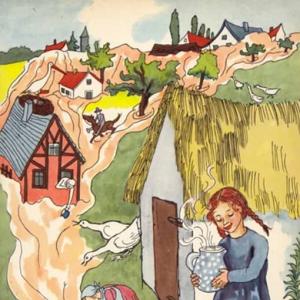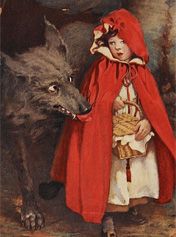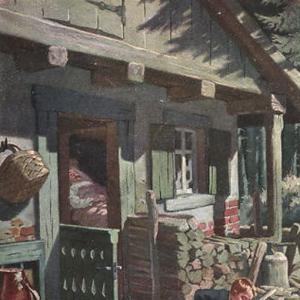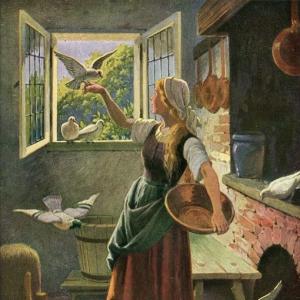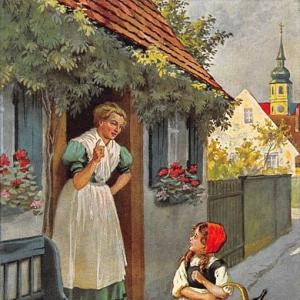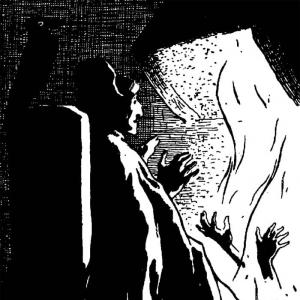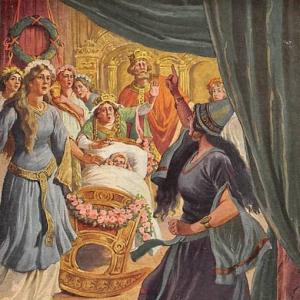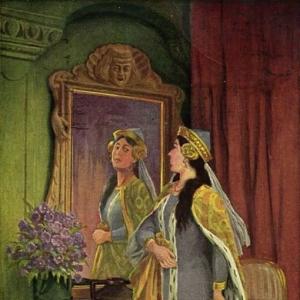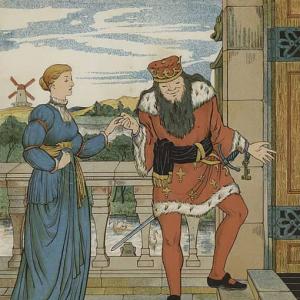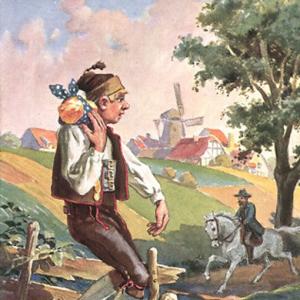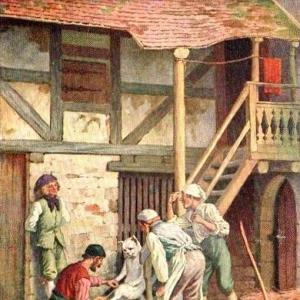Reading time: 3 min
A countryman one day said to his little puppies: „Come into the parlour and enjoy yourselves, and pick up the bread-crumbs on the table; your mistress has gone out to pay some visits.“ Then the little dogs said: „No, no, we will not go. If the mistress gets to know it, she will beat us.“ The countryman said: „She will know nothing about it. Do come; after all, she never gives you anything good.“ Then the little dogs again said: „Nay, nay, we must let it alone. We must not go.“ But the countryman let them have no peace until at last they went, and got on the table, and ate up the bread-crumbs with all their might. But at that very moment the mistress came, and seized the stick in great haste, and beat them and treated them very hardly. And when they were outside the house, the little dogs said to the countryman: „Dost, dost, dost, dost, dost thou see?“ Then the countryman laughed and said: „Didn’t, didn’t, didn’t, you expect it?“ So they just had to run away.
 Learn languages. Double-tap on a word.Learn languages in context with Childstories.org and Deepl.com.
Learn languages. Double-tap on a word.Learn languages in context with Childstories.org and Deepl.com.Backgrounds
Interpretations
Adaptions
Summary
Linguistics
„The Crumbs on the Table“ is a short fairy tale collected by the Brothers Grimm, Jacob and Wilhelm, who were German scholars, linguists, and cultural researchers. The Brothers Grimm are best known for their collection of German folklore and fairy tales, which they began publishing in the early 19th century. Their work aimed to preserve the rich oral tradition of Germanic storytelling, as well as to contribute to the development of a national identity during a time of significant cultural and political change in Germany.
The Brothers Grimm’s collection, known as „Grimms‘ Fairy Tales“ or „Children’s and Household Tales“ (Kinder- und Hausmärchen), contains over 200 stories that have become an integral part of Western literary culture. Many of these stories, such as „Cinderella,“ „Snow White,“ and „Hansel and Gretel,“ have become universally recognized and beloved over time.
„The Crumbs on the Table,“ like many of the Brothers Grimm’s tales, serves as a morality lesson for children, using animals as characters to teach values and life lessons. These stories often contain darker elements, as seen in the harsh punishment inflicted upon the puppies in this tale, reflecting the realities of life in the early 19th century. While „The Crumbs on the Table“ may not be as well-known as some of the more famous Grimms‘ tales, it shares the same themes of morality, trust, and consequences that are present throughout their collection.
„The Crumbs on the Table“ is a simple yet meaningful fairy tale that offers several interpretations, touching on themes such as trust, temptation, obedience, and consequences.
Trust: The story highlights the importance of trust in relationships. The puppies initially express their reluctance to disobey their mistress, but the countryman convinces them otherwise. By betraying their mistress’s trust and not listening to their instincts, the puppies face harsh consequences. This teaches readers to be cautious of who they trust and to remain loyal to those who have their best interests at heart.
Temptation: The tale also deals with the theme of temptation, as the puppies are lured into eating the crumbs despite their initial resistance. The story serves as a reminder that giving in to temptation can often lead to undesirable outcomes, and that it is essential to exercise self-discipline and resist momentary pleasures in favor of long-term wellbeing.
Obedience: The puppies‘ punishment is a result of their disobedience, and the story underscores the importance of following rules and respecting authority. This can be seen as a moral lesson to children, teaching them to listen to their guardians and be mindful of consequences when they choose to break the rules.
Consequences: Finally, the story demonstrates the inevitability of consequences for one’s actions. The puppies are unable to escape the consequences of their disobedience, despite the countryman’s assurance that their mistress would not find out. This serves as a cautionary tale, reminding readers that actions have repercussions, and that it is wise to consider potential consequences before making decisions.
Overall, „The Crumbs on the Table“ can be interpreted as a cautionary tale that teaches valuable life lessons about trust, temptation, obedience, and the consequences of one’s actions.
„The Crumbs on the Table“ is a lesser-known fairy tale from the Brothers Grimm, but it has inspired several adaptations in different forms of media. Here are a few examples.
„The Soldier’s Tale“ by Igor Stravinsky: This musical composition by Stravinsky is based on several folk tales, including „The Crumbs on the Table“. The soldier’s journey is depicted through a combination of music and spoken word, and the story is brought to life through the use of different instruments.
„The Soldier and the Dancing Princesses“ by The Brothers Hildebrandt: This illustrated children’s book is an adaptation of „The Crumbs on the Table“ combined with the classic fairy tale „The Twelve Dancing Princesses“. The story follows a soldier who discovers a secret kingdom where the princesses dance every night, and he uses his magic tablecloth to win their trust and help them escape from an evil king.
„The Magic Tablecloth“ by Barbara Baumgartner: This picture book adaptation of „The Crumbs on the Table“ follows a young boy who is given a magic tablecloth by an old woman. The boy uses the tablecloth to help his family and neighbors, and he learns the importance of kindness and generosity.
„Tablecloth of Turin“ by Mark T. Sullivan: This novel is a modern-day adaptation of „The Crumbs on the Table“. The story follows a young man who discovers a magical tablecloth that can produce delicious food, and he uses his newfound wealth to help those in need. The novel explores themes of morality, greed, and the power of kindness.
Overall, these adaptations of „The Crumbs on the Table“ demonstrate the enduring appeal of this classic fairy tale, and the many ways in which it can be reimagined and retold for new audiences.
In the fairy tale „The Crumbs on the Table“ by Brothers Grimm, a countryman tries to coax his little puppies into the parlour to eat the bread crumbs on the table while their mistress is away. At first, the puppies refuse, fearing that their mistress will find out and punish them. However, the countryman is persistent and eventually convinces them to go into the parlour and eat the crumbs.
As the puppies enjoy their feast, the mistress returns home unexpectedly and catches them in the act. She angrily grabs a stick and beats the puppies, treating them harshly for their disobedience. Once outside, the puppies confront the countryman, repeating „Dost, dost, dost, dost, dost thou see?“ to indicate their displeasure. The countryman merely laughs at their predicament, responding with „Didn’t, didn’t, didn’t, you expect it?“ The puppies are left with no choice but to run away, having learned a valuable lesson about trust and obedience.
The fairy tale „The Crumbs on the Table“ by the Brothers Grimm presents a simple narrative with underlying themes and linguistic features that are characteristic of traditional folk tales.
Dialogue and Repetition: The story predominantly relies on dialogue to convey its narrative, a common feature in oral storytelling traditions. The repetition in the dialogue, such as the little dogs‘ refusals („No, no, we will not go“) and the countryman’s persuasions („Do come“), emphasizes the characters‘ perspectives and the central conflict. This repetition creates rhythm and aids in memorability.
Use of Direct Speech: Direct speech is used extensively, making the tale more engaging and immediate. This technique draws readers or listeners directly into the interactions between characters, fostering a sense of participation in the unfolding events.
Moral Lesson and Anthropomorphism: The tale imparts a moral lesson about the consequences of yielding to temptation and peer pressure. The little dogs are anthropomorphized, possessing human-like caution and speech, which makes the moral applicable to human behavior. Anthropomorphism is a common device in fairy tales to simplify complex human traits and ethical dilemmas.
Simple Syntax and Lexicon: The language of the tale is straightforward, employing simple sentences and an uncomplicated vocabulary. This makes the story accessible to a broad audience, including children, which aligns with the Brothers Grimm’s purpose of preserving and disseminating folk wisdom.
Conflict and Resolution
The story centers around a basic conflict: the temptation faced by the little dogs and the eventual punishment they receive, illustrating a clear cause-and-effect relationship. The resolution, although punitive, reinforces the idea of learning from one’s mistakes—a staple in many moral tales.
Colloquial Tone: The use of colloquial expressions such as „Come into the parlour and enjoy yourselves“ gives the narrative a homely, informal tone. This contributes to the story’s charm and relatability, making readers feel as though they are part of a communal storytelling experience.
Irony: There is an element of irony in the conclusion, where the countryman mocks the little dogs with „Didn’t, didn’t, didn’t, you expect it?“ The irony underscores the moral lesson that warnings and instincts should not be ignored.
In summary, „The Crumbs on the Table“ uses linguistics effectively to create a moral tale that is engaging, memorable, and instructive. Through simple language, direct dialogue, and repetition, the story imparts lessons on caution and the consequences of misbehavior, all wrapped in a format that is both entertaining and educational.
Information for scientific analysis
Fairy tale statistics | Value |
|---|---|
| Number | KHM 190 |
| Aarne-Thompson-Uther-Index | ATU Typ 236 |
| Translations | DE, EN, ES, FR, PT, IT, JA, NL, PL, RU, TR, VI |
| Readability Index by Björnsson | 24 |
| Flesch-Reading-Ease Index | 86 |
| Flesch–Kincaid Grade-Level | 5.1 |
| Gunning Fog Index | 7.4 |
| Coleman–Liau Index | 7.9 |
| SMOG Index | 7.3 |
| Automated Readability Index | 5.1 |
| Character Count | 976 |
| Letter Count | 736 |
| Sentence Count | 12 |
| Word Count | 183 |
| Average Words per Sentence | 15,25 |
| Words with more than 6 letters | 16 |
| Percentage of long words | 8.7% |
| Number of Syllables | 228 |
| Average Syllables per Word | 1,25 |
| Words with three Syllables | 6 |
| Percentage Words with three Syllables | 3.3% |

 Facebook
Facebook  Whatsapp
Whatsapp  Messenger
Messenger  Telegram
Telegram Reddit
Reddit